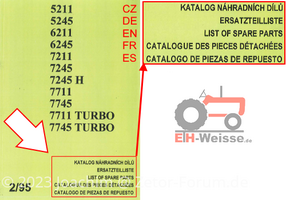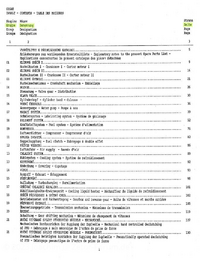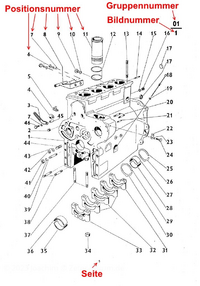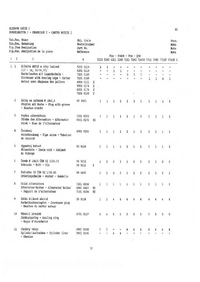- Joined
- Sep 9, 2012
- Messages
- 792
- Location
- Wiedemar, Germany
- First name
- Joachim
Machinery:
Zetor 2011, Zetor 3045, Zetor 5011, Zetor 7340 Economic
Use Zetor spare parts catalogs correctly
Using Zetor spare parts catalogs correctly - sounds banal, you can read, but the devil is once again in the details.
Almost all Zetor spare parts catalogs for the UR1 (Zetor 2011 - 7341 Turbo), but also most of the others for UR2 (Zetor 8011-18345), UR3 (7520-11540), Proxima, Major etc., are structured according to largely the same scheme, and I would like to explain this a bit here so that you can easily find your way around the spare parts catalogs in the future.
Overview
1. Languages
Most of the available spare parts catalogs (hereinafter referred to as ETK) from Zetor are multilingual:
Czech, German, English, French and Spanish
They are also available in one language, but in German only from GDR production. The languages printed in the catalog can always be found on the title page.
2. Table of Contents
Almost all ETKs start with an overview of contents, in which you quickly get an overview of which group number you can find what on which page.
3. Explanations
The table of contents is usually followed by “Explanations to the present spare parts list”, which describes what can be found in which column in the ETK tables.
4. Comments
5. Structure of the spare part numbers
6. Summary
Using Zetor spare parts catalogs correctly - sounds banal, you can read, but the devil is once again in the details.
Almost all Zetor spare parts catalogs for the UR1 (Zetor 2011 - 7341 Turbo), but also most of the others for UR2 (Zetor 8011-18345), UR3 (7520-11540), Proxima, Major etc., are structured according to largely the same scheme, and I would like to explain this a bit here so that you can easily find your way around the spare parts catalogs in the future.
Overview
- Languages
- Table of Contents
- Explanations
- Comments
- Structure of the spare part numbers
- Summary
1. Languages
Most of the available spare parts catalogs (hereinafter referred to as ETK) from Zetor are multilingual:
Czech, German, English, French and Spanish
They are also available in one language, but in German only from GDR production. The languages printed in the catalog can always be found on the title page.
2. Table of Contents
Almost all ETKs start with an overview of contents, in which you quickly get an overview of which group number you can find what on which page.
e.g.:
Image 1: ETK Zetor 5211 - 7745
Group, group name, page
3. Explanations
The table of contents is usually followed by “Explanations to the present spare parts list”, which describes what can be found in which column in the ETK tables.
e.g.:
- Column 1, spare parts picture number on which the respective spare part is shown
- Column 2, spare part position number under which you can find it in the spare parts picture
- Column 3, name of the spare part (often multilingual)
- Column 4, spare part number
- the number of spare parts installed according to the Zetor model is stated here
- Column 5, comments see the following overview
4. Comments
+ special request, is assembled to the customer's order (i.e. not "series")
* Spare part not available, will not be delivered as a replacement
X Spare part no longer available (can no longer be delivered or was no longer installed)
N0 Spare part only available in the spare parts warehouse, but is no longer installed on the tractor
0 Tractor without cab
1 tractor with cab BK 7011 (see nameplate of the cab, usually in the rear)
2 tractor with cab BK 6011 (ditto)
Further and different comment marks are possible and are then explained at the end of the respective spare parts group list in the catalog.5. Structure of the spare part numbers
Type-based spare part numbers
were mainly used on older models than the Zetor UR1, such as the Zetor 25 or 50 Super:
e.g. S105.0128 or Z25.1026.09
Where the 105 would stand for the Zetor 50 Super and Z25 would stand for the Zetor 25. However, Zetor has this notation with the introduction of the Zetor UR1 abandoned again.
6-digit spare part numbers
are often standard or standard parts, such as screws, ball bearings, sealing rings, ... or individual parts such as valves, for example, which have been installed in a large number of Zetor models over years or decades.
e.g. 97-9031 or 99-1427 etc.
Note - The first two digits have NOTHING! to do with the year of manufacture, but with the grouping of parts and the manufacture:
- Standard components:
- 99-xxxx - are usually fastening or connecting parts
- 97-xxxx - are usually securing or sealing parts
- Externally produced parts:
- 93-xxxx - are components that are not/were not manufactured in the tractor factory itself, such as electrical parts (PAL)
Old 8-digit spare part numbers (old notation)
are somewhat more special numbers that are usually structured as follows
e.g. 6901-0269[/ I]
- 69 - gives an indication of which series the part was first regularly installed on - here from the 9 series (Zetor 6911, for example).
For example, a 25, 35, 45 or 55 would represent the introduction of the spare part with the 5 series (e.g. Zetor 2511, 3511, 4511, 5511) etc.
But that doesn't mean that these parts won't fit or be used in earlier or later models! - 01 - is a consecutive number
- 02 - is usually the number of the spare parts group in which this part can be found. The part can also appear in other spare part groups, which is often the case with small parts, for example.
- 68 - is a consecutively assigned part number
- 69 - gives an indication of which series the part was first regularly installed on - here from the 9 series (Zetor 6911, for example).
Newer 8-digit spare part numbers (new notation)
were introduced with the Zetor UR2 series and are still being reassigned today
e.g. 53-369-046
Here the 369 would stand for the spare parts group, for example, and 046 would be a consecutive number.
6. Summary
In addition, depending on the Zetor spare parts catalog, there are also other important information, such as the specific VINs (vehicle identification numbers) from or until which component is/was used. Or references to special models such as the 3513 or the John Deere versions.
You can often also find measurements or references to the original equipment manufacturer.
You can now orientate yourself in the various spare parts catalogs and look for spare part numbers in order to order a required spare part if necessary.
When ordering, please always include the Zetor model name, year of manufacture and any additional equipment installed to ensure smooth procurement of spare parts. If you are unsure, photos can often say more than a thousand words.
... e.g. at ETH-Weisse.de 




